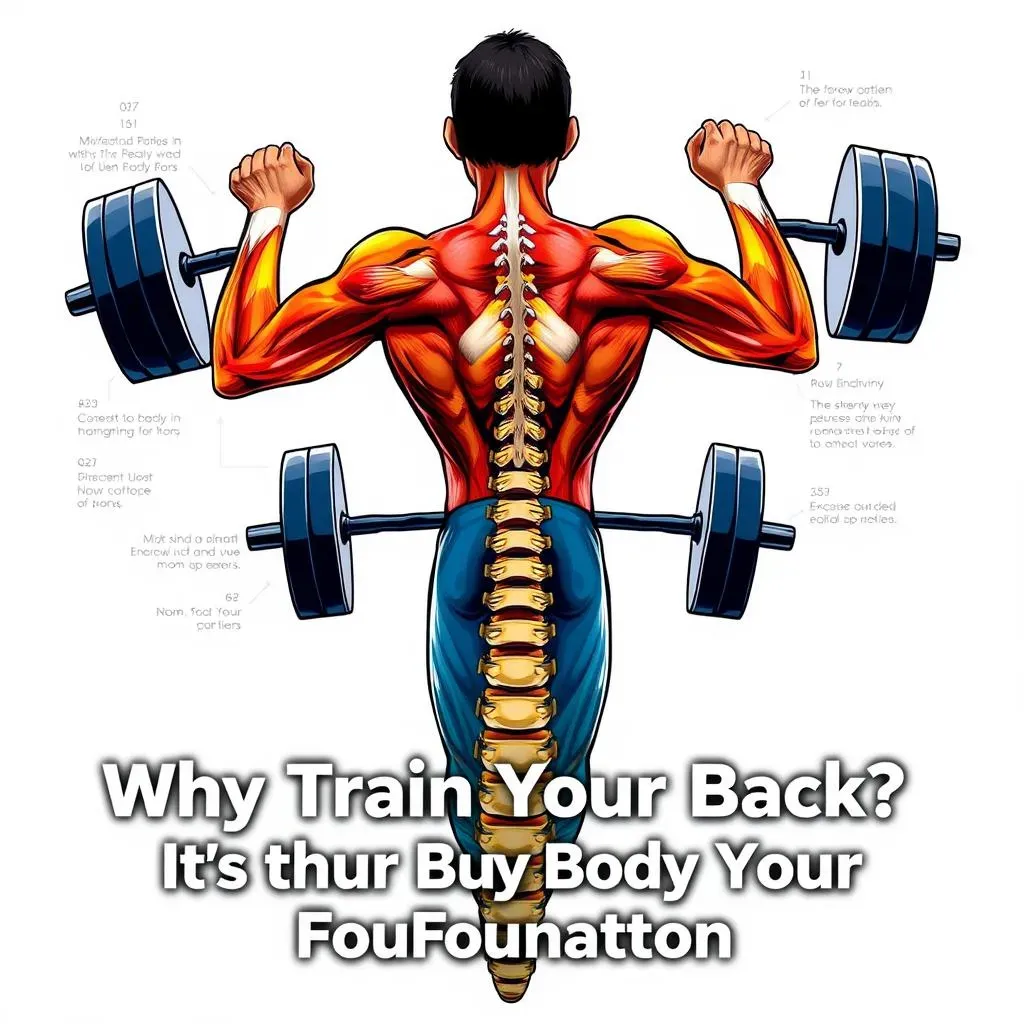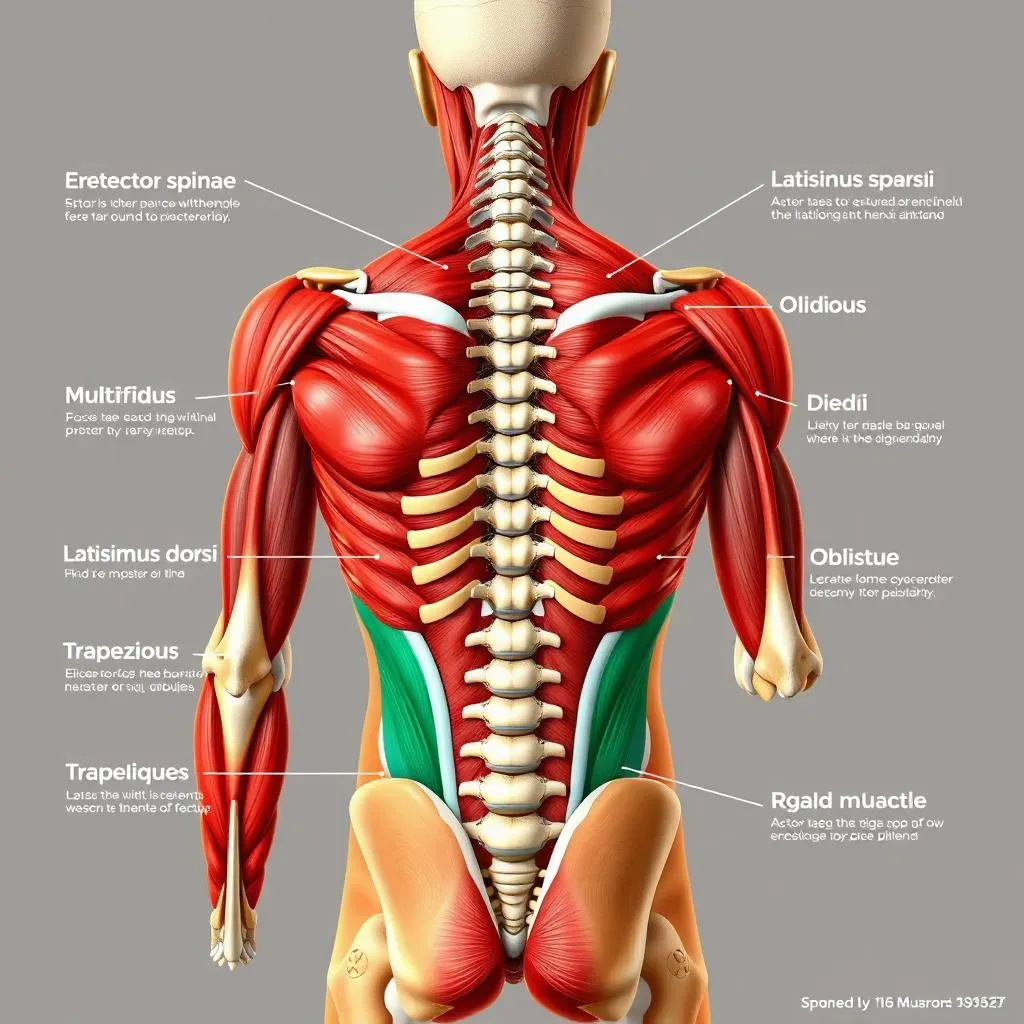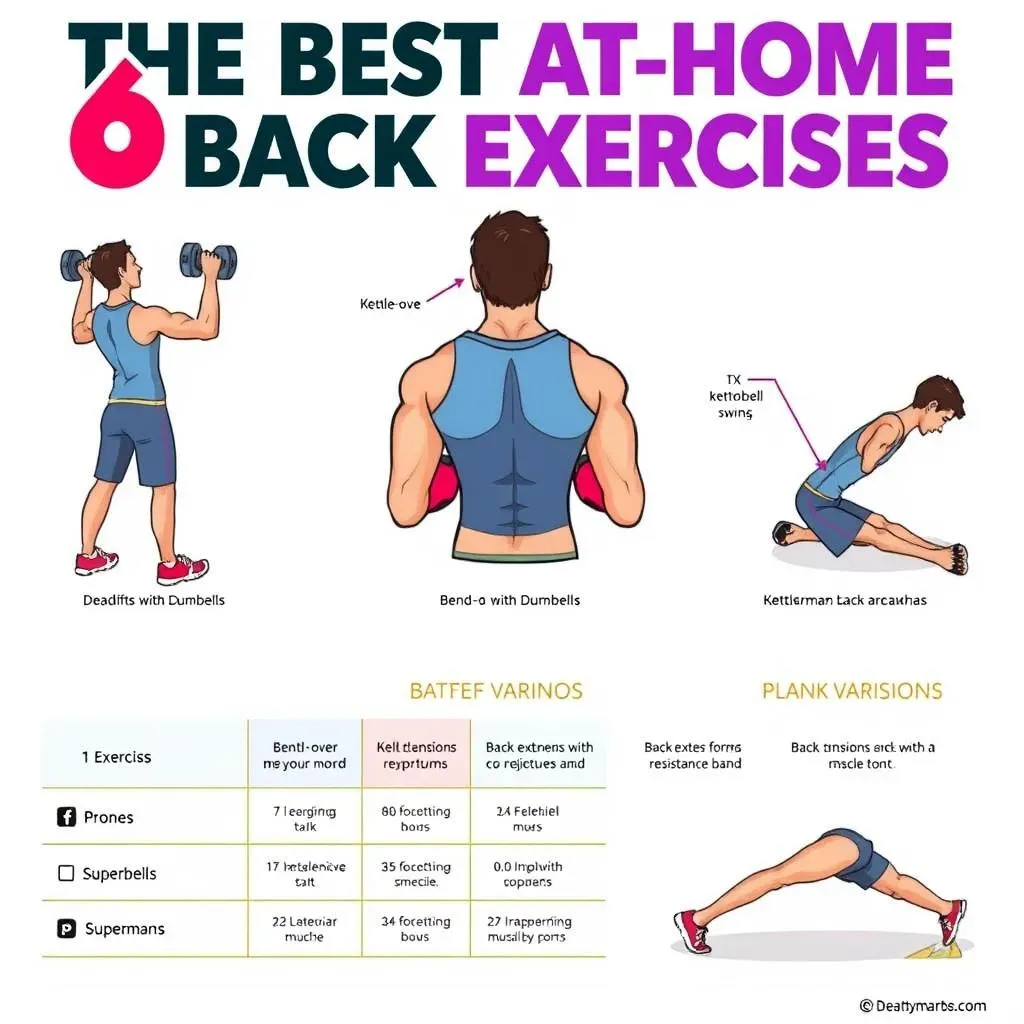Table of Contents
Ever dreamt of having a back that looks like it could stop a train? Or maybe you're just tired of that nagging back pain? You're not alone! Millions of people struggle with back issues, and a lot of it comes down to weak back muscles. But here's the good news: you don't need a fancy gym to build a strong, impressive back. Forget expensive equipment and crowded spaces. I'm going to show you the absolute best back workouts at home. Seriously, just your own body, maybe some dumbbells, or a kettlebell is all you need to get started. We'll break down why a strong back is so important, what muscles we're actually targeting, and the smartest way to train them. Then, I'll give you the lowdown on six killer exercises you can do at home, followed by three complete workouts to get you started. So, ditch the excuses, let's get to work, and sculpt a back that's both powerful and pain-free. Prepare for results!
Why You Need to Train Your Back

Why You Need to Train Your Back
Okay, so you're wondering why you should even bother with back exercises, right? It's not like it's the first thing people see when they look at you. But let me tell you, neglecting your back is like building a house on a shaky foundation. It's a recipe for disaster. A strong back isn't just about looking good in a tank top, though that's a nice bonus. It's about having a body that can handle the stresses of everyday life. We're talking about preventing those awful aches and pains that make you feel like you're 90 years old. Did you know that around 10 million people in England and Scotland alone experience persistent back pain? That's a lot of people suffering, and honestly, it's often avoidable. A solid back is your body's support system, and when it's weak, everything else suffers.
Think of your back as the unsung hero of all your movements. It's the powerhouse that allows you to lift heavy things, whether it's a box of books or a barbell loaded with weights. Ever tried deadlifting without a strong back? Trust me, it's not pretty. Your back is the key to powerful squats and helps you resist all sorts of strains and injuries. It's also the backbone for good posture. Ever see those people who look like they're always slouching? Yeah, that's often a sign of a weak back. I'm not saying you'll look like a superhero overnight, but with a strong back, you'll move better, feel better, and honestly, you'll look better too. It's all connected, and it all starts with a solid foundation.
Benefit | Description |
|---|---|
Pain Prevention | Reduces the risk of back aches and pains. |
Strength Foundation | Supports heavy lifts and everyday movements. |
Injury Resistance | Helps to resist strains and injuries. |
Improved Posture | Contributes to better posture and alignment. |
Which Muscles Make up 'the Back'?

Which Muscles Make up 'the Back'?
Alright, so we've established that a strong back is super important. But what exactly are we working with back there? It's not just one big slab of muscle, you know. It's a whole team of muscles working together. Think of them like different players on a sports team, each with their own role to play. First up, we've got the erector spinae, which run along your spine. These are like the main support beams of your back, keeping you upright and strong. Then there's the multifidus, deeper muscles that help stabilize your spine. They're like the tiny but mighty workers behind the scenes. We can't forget the obliques, they're on the sides of your torso and help with rotation and bending. And, of course, we have the lats, or latissimus dorsi, big muscles that spread out like wings. They're the ones that give you that awesome V-shape, and help with pulling movements. Last but not least, the trapezius, or traps, which run from your neck to your mid-back. They help with shoulder movement and posture.
The Best Way to Train Your Back

The Best Way to Train Your Back
Vertical Pulls: The Foundation of Back Strength
Okay, so you've got all these back muscles, but how do you train them effectively? It's not just about randomly doing some exercises and hoping for the best. The key is to think about movements, not just muscles. For your back, you've got two main types of movements: vertical pulls and horizontal pulls. Vertical pulls, like pull-ups, are where you're pulling weight towards you in an up-and-down direction. These are fantastic for building overall back strength and targeting your lats. Think of them as the core of your back workout. They work your back in a way that helps you lift things overhead and are essential for building a powerful back.
Horizontal Pulls: Building Thickness and Detail
Next, we have horizontal pulls, such as bent-over rows. Here, you're pulling weight towards you in a front-to-back direction. These are great for building thickness in your back and targeting the mid-back muscles, like your rhomboids and traps. They’re like the artists of your back workout, adding those detailed lines and making your back look wide and strong. It’s like building a brick wall; you need both vertical and horizontal bricks for the most solid wall. You wouldn't just stack them up all one way, would you? No way!
Movement Type | Direction | Primary Muscles Worked | Example Exercises |
|---|---|---|---|
Vertical Pulls | Up and down | Lats, biceps, forearms | Pull-ups, lat pulldowns |
Horizontal Pulls | Front to back | Rhomboids, traps, mid-back | Bent-over rows, seated rows |
Mixing it Up for Maximum Gains
The best strategy is to include both types of movements in your workouts. This way, you’re training your back from different angles, ensuring you hit all the muscles and build a well-rounded back. It's like having a full tool kit, not just one tool. You need a hammer, a screwdriver, and a wrench to build a house, right? Same with your back. By incorporating both vertical and horizontal pulls, you are making sure every muscle is getting the attention it needs. Trust me, your back will thank you for it. And you'll be thanking yourself when you're lifting heavy things like a boss and not feeling like an old creaky door.
The 6 Best athome Exercises for Your Back

The 6 Best athome Exercises for Your Back
Deadlifts: The King of Back Exercises
Alright, let's get into the good stuff – the actual exercises. First up, we have the deadlift. Now, I know what you might be thinking, "Deadlifts at home? Without a barbell?" Hear me out! While a barbell deadlift is amazing, you can absolutely get a killer back workout with a modified version at home. We're talking about using dumbbells, kettlebells, or even just a heavy backpack filled with books. The deadlift is the king of back exercises for a reason. It works almost every muscle in your back, from your lower back to your traps. It's like the ultimate full-body exercise that builds strength, power, and a seriously impressive back. It’s not just about lifting weight off the floor; it’s about engaging your entire back and building a solid foundation of strength.
Bent-Over Rows: Sculpting a Thick Back
Next, we've got bent-over rows. This exercise is your go-to for building thickness in your back. It targets all those mid-back muscles, like the rhomboids and traps, giving you that wide, powerful look. You can do these with dumbbells, kettlebells, or even just a resistance band. The key is to keep your back straight and your core engaged. Imagine you are trying to pull your elbows past your back, squeezing your shoulder blades together at the top of each rep. Feel the burn? That’s how you know it’s working. Bent-over rows are all about controlled movements and getting a good squeeze in your back muscles. They're like the artists of back exercises, adding those detailed lines and making your back look wide and strong.
Exercise | Equipment | Primary Focus |
|---|---|---|
Deadlifts | Dumbbells, kettlebells, backpack | Full back strength, power |
Bent-Over Rows | Dumbbells, kettlebells, resistance bands | Mid-back thickness, detail |
Kettlebell Swings: Power and Endurance
Now, let's talk about kettlebell swings. This exercise is a powerhouse for your posterior chain, which includes your back. It’s also a great way to build some explosive power and endurance. You’re not just lifting the kettlebell with your arms, but you’re using your hips and back to generate the power, which makes it a full-body movement. It might look simple, but trust me, when you do it correctly, you'll feel it all through your back. Kettlebell swings are like the cardio of back exercises, building strength, endurance, and a rock-solid core. It’s not just about lifting the weight, but using your entire body to swing it in a fluid motion. And the best part? You don't need a ton of space to do them. You can get a full workout in your living room.
The Best Home Back Workouts

The Best Home Back Workouts
Okay, so you've got your exercises, now let's put them together into some killer workouts. We're going to focus on three different ways you can train your back at home: using dumbbells, using just your bodyweight, and using kettlebells. Each workout will include a mix of those vertical and horizontal pulling movements we talked about, ensuring you’re hitting all those back muscles. Remember, proper form is key to getting the best results. It’s better to do fewer reps with good form than a ton of reps with sloppy form. It's like baking a cake, if you mix the ingredients wrong, the result will be terrible. Always start with a good warm-up, some dynamic stretches like arm circles and torso twists, and end with some static stretches like back extensions and cat-cows.
First up, we have a dumbbell focused workout. This is great if you have a set of dumbbells at home. You’ll do 3 sets of 8-12 reps of each exercise. First, grab your dumbbells and get ready for some deadlifts. Remember to keep your back straight and hinge at your hips. Next, move into bent-over rows, focusing on squeezing your shoulder blades together at the top. Then, we'll do some renegade rows, which is like a row in a plank position. This workout is great because it hits all the major back muscles, and you can easily adjust the weight to match your fitness level. If you’re new, start light and focus on form. It's like learning to ride a bike, you start slow and then speed up once you get the hang of it. Don't be afraid to modify the exercises if needed, especially if you're new to this.
Workout Type | Exercises | Sets | Reps |
|---|---|---|---|
Dumbbell Workout | Dumbbell Deadlifts, Bent-Over Rows, Renegade Rows | 3 | 8-12 |
Next, let's move on to a bodyweight workout. This one's perfect if you don't have any equipment. We'll be doing inverted rows. Find something sturdy to hang under, like a table or a sturdy bar. You'll be pulling your chest towards the object, focusing on squeezing your back muscles. Then, we'll do some wide-grip pull-ups if you have a pull-up bar, or you can use a sturdy tree branch. If you can’t do a full pull-up, use a chair to help you, and focus on the negative (lowering yourself slowly). Finally, we'll finish with some back extensions. Lie face down and raise your upper body off the ground, engaging your lower back muscles. This workout is all about using your own body weight as resistance, which is a great way to build strength and endurance. It's like learning to swim, you don't need weights, just the water to build strength.
And finally, for those of you with a kettlebell, we have a kettlebell workout. Start with some kettlebell swings. Remember to use your hips to drive the movement. Then, we'll do some kettlebell bent-over rows, same as the dumbbell version but with a kettlebell. And lastly, do some single-arm kettlebell rows. This workout is all about building power and endurance, and the kettlebell is a fantastic tool for that. It’s like using a swiss army knife, it can do all sorts of things. These are some really effective and fun moves to do. Remember, consistency is key. Try to do these workouts 2-3 times a week, and you’ll start to see results. Just keep going, and you will get there.
- Bodyweight Workout: Inverted Rows, Wide-Grip Pull-Ups, Back Extensions
- Kettlebell Workout: Kettlebell Swings, Kettlebell Bent-Over Rows, Single-Arm Kettlebell Rows
